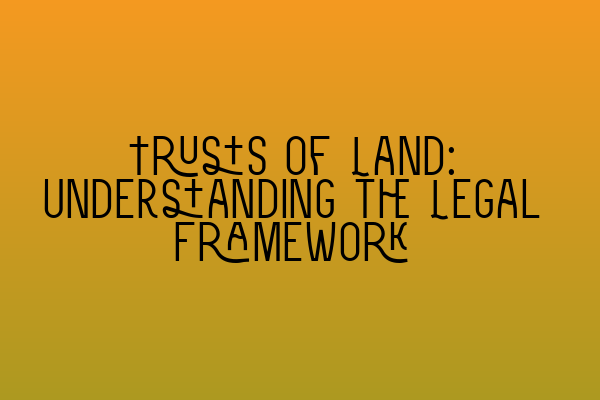Trusts of Land: Understanding the Legal Framework
Introduction
Trusts of land play a crucial role in property law, yet many people find them complex and difficult to understand. In this article, we will break down the legal framework surrounding trusts of land, providing a comprehensive overview of their purpose, types, and key considerations. Whether you are a property owner, a solicitor, or studying for the SQE exams, this guide will help you gain a deeper understanding of trusts of land.
What is a Trust of Land?
A trust of land is a legal arrangement where a property (or its proceeds) is held by one or more individuals (known as trustees) for the benefit of others (known as beneficiaries). The trustees are responsible for managing, maintaining, and distributing the property in accordance with the terms of the trust.
Purpose of Trusts of Land
Trusts of land serve several important purposes. They allow for the efficient management and administration of property, especially in cases where multiple individuals have a stake in the property. Trusts also offer protection for beneficiaries, ensuring their interests are safeguarded and managed by responsible trustees. Additionally, trusts of land provide a means for property owners to plan for the future, such as succession planning or protecting assets from creditors.
Types of Trusts of Land
There are various types of trusts of land, each with its own unique characteristics and legal considerations. Some common types include:
1. Bare Trusts: In a bare trust, the trustees hold the property for the beneficiaries but have no discretion or obligations regarding its management or distribution. The beneficiaries have absolute control over the property.
2. Fixed Trusts: In a fixed trust, the property is distributed among the beneficiaries in fixed shares or proportions as determined by the settlor (the person setting up the trust) at the time of creation.
3. Discretionary Trusts: A discretionary trust provides the trustees with the discretion to decide how and when to distribute the property among beneficiaries. This type of trust offers flexibility and can be ideal for situations where the needs of the beneficiaries may change over time.
Key Considerations
When dealing with trusts of land, several key considerations should be kept in mind:
1. Legal Formalities: Trusts of land must be created in writing to be valid. The trust deed or declaration of trust should clearly outline the property to be held, the beneficiaries, and the powers and responsibilities of the trustees.
2. Trustees’ Duties: Trustees have a fiduciary duty to act in the best interests of the beneficiaries. They must exercise reasonable care and skill in managing the property and making decisions regarding its use, maintenance, and distribution.
3. Beneficiaries’ Rights: Beneficiaries have the right to receive information about the trust and its management. They also have the right to challenge the actions of the trustees if they believe they are not acting in accordance with the terms of the trust or their fiduciary duties.
4. Trustee Powers: The powers of the trustees can vary depending on the terms of the trust deed or declaration of trust. Some trusts may provide specific instructions and limitations on the trustees, while others may grant them broad discretionary powers.
Conclusion
Trusts of land are a vital aspect of property law, providing a framework for the management, protection, and distribution of property. Understanding the legal framework surrounding trusts of land is crucial for property owners, solicitors, and anyone studying for the SQE exams. By grasping the purpose, types, and key considerations of trusts of land, you can navigate the complexities of property law with confidence and ensure the best outcomes for all parties involved.
For more information on SQE 1 practice exam questions, click here.
Prepare for SQE 1 with our practice mocks FLK1 and FLK2. Click here for more details.
For comprehensive SQE 2 preparation courses, visit here.
Studying for SQE 1? Explore our preparation courses by clicking here.
Stay up-to-date with the latest SRA SQE exam dates by visiting here.
